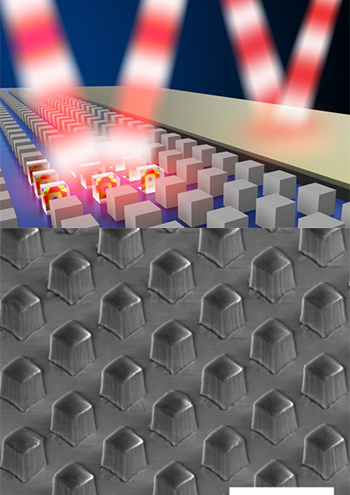
The layer of resonant tellurium nanocubes (top left), acting as a "magnetic mirror," reflects the incident infrared light without reversing the phase of light's electric field, as is the case with a conventional metallic mirror (top right). (Bottom) SEM image of tellurium nanocube layer; scale bar is 5 µm. [Image: Liu et al., Optica 1, 250 (2014)]
An orderly 2-D array of nanoscale dielectric cubes, acting as subwavelength resonators, has been used to create a “magnetic mirror” that can reflect infrared light without benefit of the usual bright metal surface (Optica, doi: 10.1364/OPTICA.1.000250). The U.S. team behind the work, from Sandia National Laboratories, N.M., and the University of California, Irvine, says that it represents the first demonstration of an optical magnetic mirror made from an all-dielectric metamaterial. And the scientists believe that the work, extended in the future, could lead to new types of chemical sensors, solar cells, and other devices.
Conventional metallic mirrors work by interactions between the metal’s free charge carriers and the electrical component of the optical electromagnetic field; the light bounces off of the metal and, in the process, the phase of the electric field is reversed. The Sandia and Irvine researchers wanted to demonstrate an alternative approach that instead exploits interactions with the field’s magnetic component. One key advantage of such a “magnetic mirror” would be that it would leave the electric-field phase of the light unreversed. That, in turn, would allow a stronger interaction for nanodevices and sensors at the surface of the mirror than in conventional metallic mirrors, in which the phase reversal between the incoming and outgoing electric field tends to cancel out the field at the immediate point of reflection.
To create the magnetic mirror, the team fashioned a layer of tellurium (Te) cubes, with a subwavelength edge length of approximately 1.5 µm, atop a low-reflectivity barium fluoride substrate. Each of the cubes of Te—a material with a high refractive index and a strong response at infrared wavelengths—acts as a resonator or “artificial atom,” absorbing and re-emitting the incident light. The researchers confirmed, via time-domain spectroscopy, that the phase of the electric field component was not reversed in the reflected light—“the ultimate demonstration,” according to lead author Sheng Liu, “that this patterned surface behaves like an optical magnetic mirror.”
As the technique is extended from infrared into visible wavelengths, the team expects it to open up new applications. In particular, the lack of phase reversal at the mirror surface could allow for a strong interaction of the light with chemically selective layers spread at the surface, enabling creation of new kinds of highly sensitive chemical sensors based on the spectral characteristics of the reflected beam. The same strong surface interaction, Liu suggests, could also be pressed into service in other applications—“smaller photodetectors, solar cells, and possibly lasers.”
